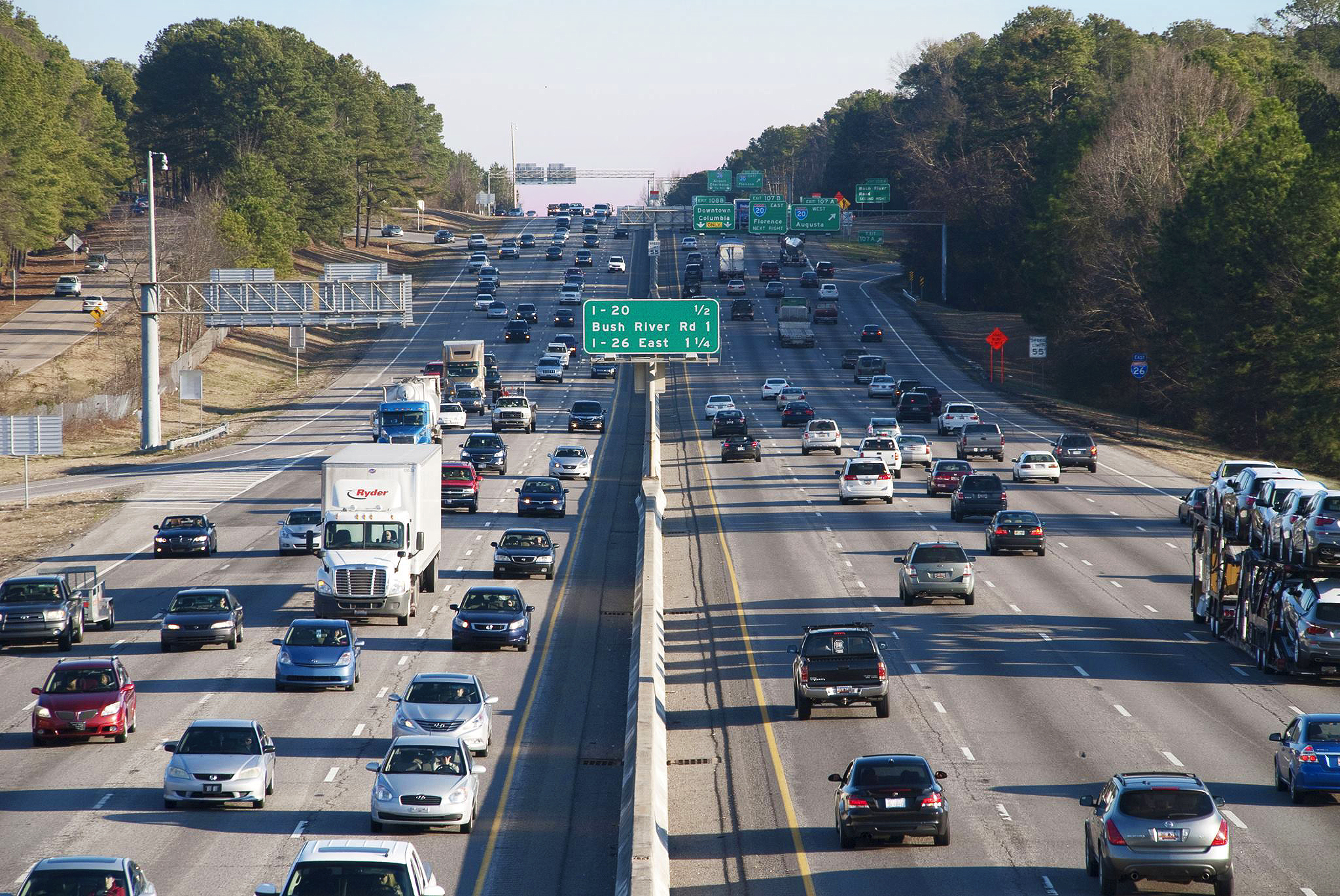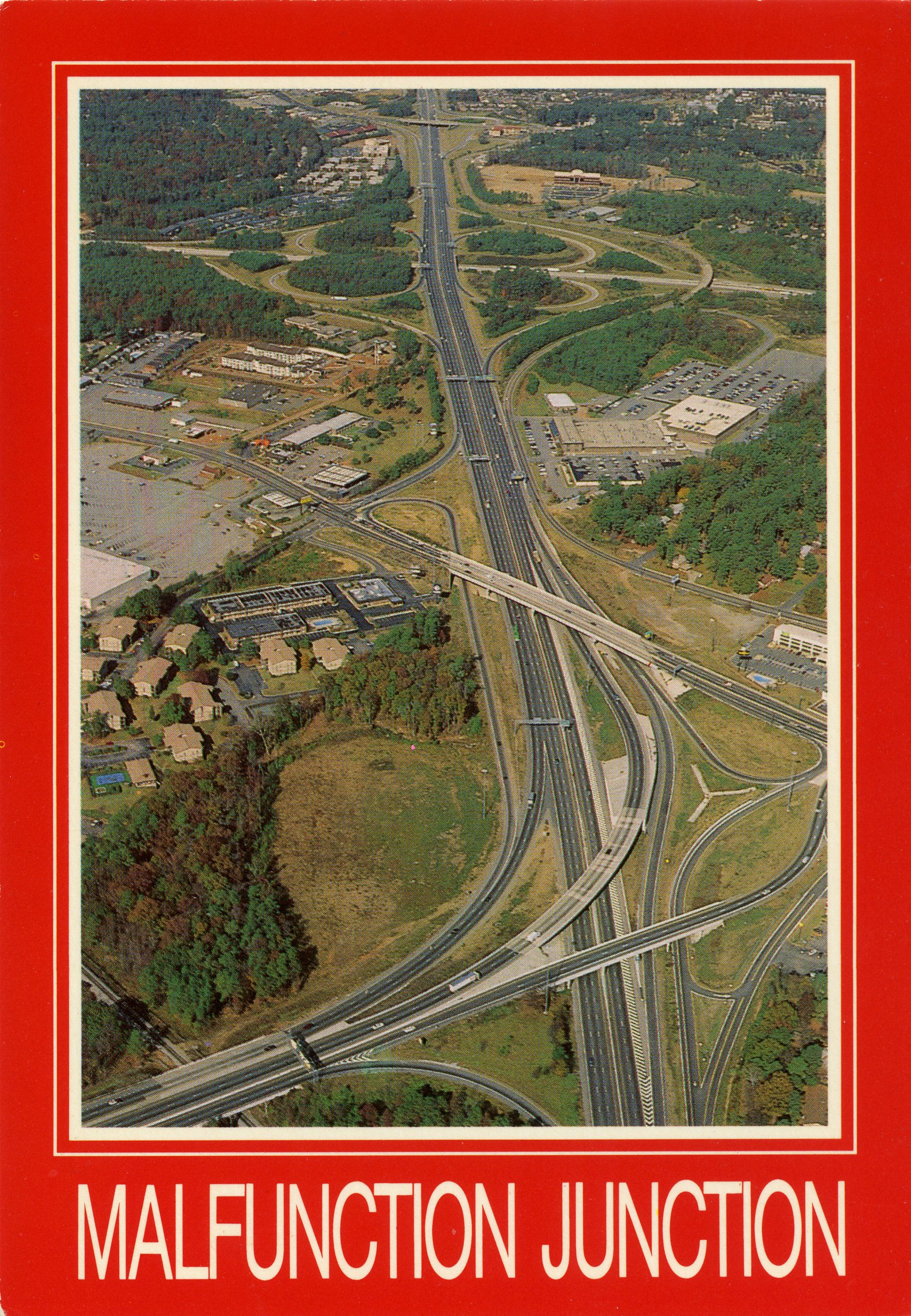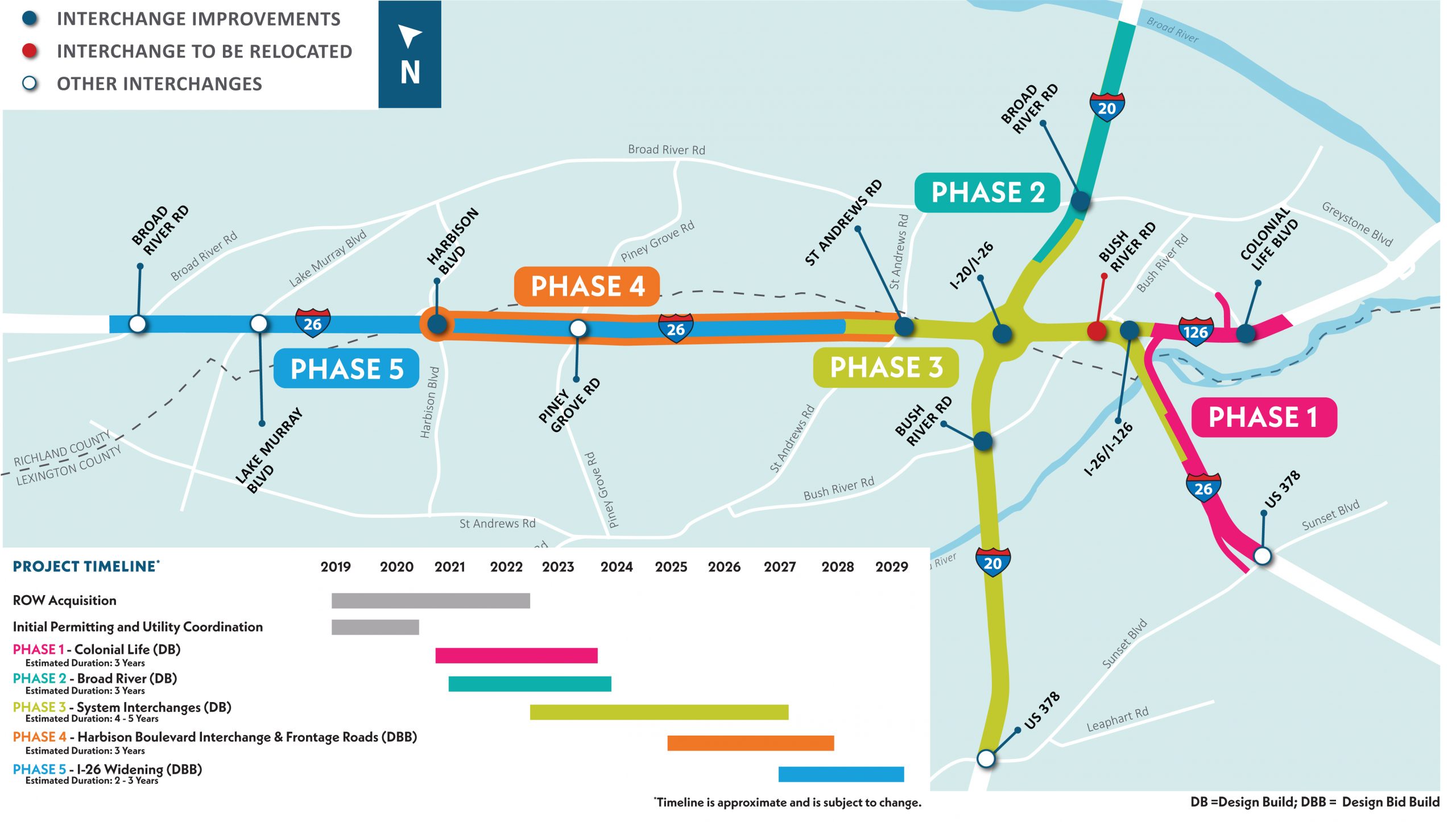
A familiar sight to any local, I-26 looking southeast from the St. Andrews Road bridge over I-26 is frequently packed with traffic.
Anyone who has traveled through the Midlands of South Carolina from north to south or east to west has likely experienced the frustrating web of interstate interchanges, dubbed Malfunction Junction for many years. This interstate interchange is a confusing, congested conglomeration of ramps, merge lanes, and signage that confounds even the most attentive driver.
Jenny Boulware moved to the Midlands in 2018 from West Virginia to take a job in downtown Columbia. While she had lived in South Carolina before, being away in a more rural environment for many years made Jenny very cognizant of having to consider traffic patterns when she and her family decided where to buy their house.
“We wanted land, and you can’t really get that downtown,” Jenny says. “We ended up really liking Chapin. Then my husband said, ‘You do realize that the drive from Chapin to Columbia is the 66th worst in the nation.’ I’ve never really had to commute anywhere – this was all new to me.”
Pre-COVID, Jenny, like thousands of other daily commuters who pass through Malfunction Junction daily, learned to be very strategic in her driving. “There’s truly a window of opportunity. If you have a little misstep and forget something back at the house, it can mean a significantly longer commute time,” Jenny says. “It’s 22 miles door to door for me. If I miss my window for a smooth drive into town, those 22 miles can take about an hour and 15 minutes. If that happens, it’s a matter of patience.”
Today, there’s an end in sight for commuters like Jenny who make this trek daily. Malfunction Junction, now called Carolina Crossroads, is getting an overhaul that will be the largest and most costly infrastructure project South Carolina has ever seen. Estimated ultimately to cost $1.6 billion, the project has been underway with planning since 2015. The South Carolina Department of Transportation estimates the entire 14-mile project will be finished by the time Jenny’s youngest daughter gets her driver’s license in 2029.
According to the South Carolina Department of Transportation, 135,700 cars travel daily on the strip of interstate connecting I-20 and I-26. Additionally, the count for cars per day between I-20 and St. Andrews Road totals 148,000. And population continues to grow in the area. The Central Midlands Council of Governments projects the population in the region will increase by 70 percent by 2040 while employment should increase by more than 11 percent.
When the project is finished, SCDOT estimates the average driver will save 112 hours annually in traffic, according to Brian Klauk, the project manager for Carolina Crossroads. For all drivers, this adds up to 18 million total hours annually.
But it’s not just the commuters driving into Columbia or visitors passing through the center of the state who contribute to the bottlenecks. Cargo headed to the state’s port in Charleston is also adversely impacted by the traffic along this corridor, says Carl Blackstone, president of the Greater Columbia Chamber of Commerce.
“Economic development is really driven by the port, but to get to the port, you’ve got to have access to get there,” Carl says. “South Carolina has grown so much population-wise that our roads are just chock full. We need to expand the infrastructure in order to carry the new people but also to protect the investment in the port to get goods and services from the upstate to Charleston. This area is the cog of the wheel.”
According to SCDOT, Carolina Crossroads is intended to do just that – improve mobility and enhance traffic operations by reducing traffic congestion along the I-20/I-26/I-126 corridor while accommodating future traffic needs.
 The back of this old postcard reads, “Infamous junction of three interstate highways, two nearby rivers, shopping centers, and other traffic obstacles make this the best known intersection in the state.” Why not write home about it? Photography courtesy of Richland Library
The back of this old postcard reads, “Infamous junction of three interstate highways, two nearby rivers, shopping centers, and other traffic obstacles make this the best known intersection in the state.” Why not write home about it? Photography courtesy of Richland Library
This stretch of I-20, I-26, and I-126 dates back to the Kennedy Administration. The first stretch of I-26 opened in 1960, and I-126 opened in 1961. “Standards were fine for the traffic flow then, which is one-sixth of what it sees today,” Brian says.
The first widening of this section of interstate happened in 1976 when I-26 went from four lanes to six from Piney Grove Road to Greystone Boulevard. The interchange at I-20 and Bush River Road opened in 1981, and the “flyover” connection from I-126 westbound to I-26 eastbound opened in 1985. In 1993, I-26 expanded to six lanes, and in 1997, the Lake Murray Boulevard exit off I-26 was reconstructed into a six-ramp partial cloverleaf.
As the Midlands area grew and traffic got more congested, other highway projects around the state were also vying for more funding. Studies started as far back as the 1970s and continued into the 80s to begin looking at alternatives to alleviate some of the Malfunction Junction congestion. “SCDOT actually generated a fix in the 1980s,” Brian says, “but other funding projects took priority. As our state has grown, so many other areas needed investment or construction.”
The state Secretary of Transportation, Christy Hall, worked on a fix for Malfunction Junction back in the mid-1990s, Brian says. “She’s got an amazing connection to this project. She worked on the project as a young design engineer. She’s been involved from early in her career to now being secretary of transportation in charge of making the whole fix happen.”
Brian, too, has been around SCDOT for many years. He says working on a monumental project like this is a once-in-a-career opportunity for someone in his line of work. He has worked for the state since 1999, with SCDOT and the Department of Parks, Recreation and Tourism before that, and did private sector work previously.
“I’m just one person on a huge team on this project,” Brian says. “We have more than 400 engineers, environmental scientists, and economists in SCDOT and in partnership with consulting firms who have worked on this project. We couldn’t do it without the private sector.”
 Overall map of Carolina Crossroads showing the five phases of construction and their approximate construction schedules.
Overall map of Carolina Crossroads showing the five phases of construction and their approximate construction schedules.  Cross section of the finished I-26 between I-20 and I-126.
Cross section of the finished I-26 between I-20 and I-126.
While the need to overhaul Malfunction Junction has been on state leaders’ radar for decades, funding remained a major roadblock. The cost of the project is by far the heftiest infrastructure investment ever seen in South Carolina. The state’s contribution is about 10 percent of the total cost, with the federal government making up the rest.
Movement toward lining up the necessary state funding started with the passage of Act 98 in 2013 that allocated state dollars through the State Infrastructure Bank for expanding, rehabilitating, and improving the state’s interstates. Then, a 2017 increase in the state’s gas tax helped fund the rest of the state’s investment – and is helping to fund a significant increase in SCDOT work to repair roads and bridges across the state.
Numerous state and federal agencies work in tandem to carry out a project like this. The South Carolina Department of Transportation and the Federal Highway Administration share responsibility for developing transportation infrastructure in the states. Federal law requires these lead agencies to identify and involve the appropriate agencies and also provide oversight in managing the process and resolving issues.
The Carolina Crossroads planning process includes 17 state, federal, and tribal agencies ranging from the Army Corps of Engineers to the Catawba Indian Nation and the S.C. Department of Archives and History to two Midlands counties. This diverse group of agencies was involved with the planning process that included lots of public input and evaluation of dozens of alternative plans. This process considered many variables including air quality, noise, water quality and floodplains, land use planning, and socioeconomic issues.
“We started in the summer of 2015 with public meetings. We asked the public to tell us about what solutions they might see,” Brian says. “We started by casting a wide net and narrowed it down over a series of years through engineering studies, environmental studies, and public involvement at every step.”
Public input through a strategically developed outreach plan was key to the success of this early planning. The public outreach for the project was wide-reaching and has won several awards from both public relations and engineering professional organizations including the S.C. Chapter of the Public Relations Society of America, the American Council of Engineering Companies of South Carolina, and the American Society of Civil Engineers. From 2015 to 2019, the Carolina Crossroads outreach efforts delivered 23,000 newsletters; 37,000 postcards; 10,000 video views; 100,000 website visitors; and 1,400 social media followers.
Another result of the public outreach part of the process was a positive outcome for a neighborhood that could have been adversely impacted by a proposed bridge. Back in 2018, early planning for the project had homeowners in the Whitehall neighborhood off St. Andrews Road concerned over the possibility that a proposed bridge could negatively impact them. After hearing the arguments from concerned neighbors, SCDOT determined that the proposed bridge wouldn’t have a substantial impact in reaching the ultimate goal of improving traffic.
This early public input coupled with engineering and environmental studies led to the FEIS – or Final Environmental Impact Statement – that gets the project to about 30 percent of its design. Brian says, “This part of the process identified things like where ramps should be, preliminarily looked at property that needed to be purchased; and included traffic studies. It commits us to doing certain things for the environment and to offset things where the construction will have an impact.”
Brian says SCDOT has worked to balance any negative impact from the Carolina Crossroads construction with preserving wetlands properties in other parts of the state. “We’ve done a robust mitigation and purchased land in Newberry and Laurens counties, creating mitigation property and then turning it over to DNR for safekeeping in perpetuity.”
In addition to environmental concerns, SCDOT had to look out for archeological treasures when plotting the plans for Carolina Crossroads, Brian says. “The Saluda Canal is a fascinating archaeological resource near the zoo. Between 1819 and 1821, it was used to bypass the rapids. Ruins and residue of that canal are still there. We made a commitment to engineer around it.”
The project got its final green light from the Army Corps of Engineers in September 2020, clearing the way for work to begin. The plan for this mammoth infrastructure project is divided into five phases, including the process of selecting engineering and construction companies.
The process SCDOT is using for phases 1, 2, and 3 is called design-build. It involves the department hiring an engineering firm and a construction firm to work in tandem on the project. Together they finish design and conduct construction as a team.
The department started the design-build procurement process in the spring of 2020. Construction will start toward end of 2021. “It’s a long process to hire a contractor and designer,” Brian says.
“The traditional way is to hire an engineering firm to generate the plans, then hire a construction company to build,” Brian says. “Using this design-build process enables speed because the design and construction processes work together to bring the most innovation to the project.”
Phases 4 and 5 will be built by the traditional method called design-bid-build. “We are starting design early, and it’s already underway,” Brian says. “We want to be able to have engineering firms working now with designs ready to go when we are ready for construction.”
HDR and CDM Smith were selected to assist in procuring the design-build phases of the project and in overseeing construction activities. Both are international companies with South Carolina-based offices.
Phase 1, which starts in 2021, will run between I-26 at Highway 378, move to the I-126 interchange and east toward Columbia past the Colonial Life Boulevard exit. This phase will involve improvements to the Colonial Life exit interchange. This work should be completed in 2024.
Phase 2 will also start in 2021. It will include interchange improvements at the Broad River Road exit off I-20 with completion expected in 2024. This phase impacts I-20 from the Broad River west to the stretch just west of the Broad River Road exit.
Phase 3 tackles the epicenter of Malfunction Junction where I-20 and I-26 meet. The construction will affect the exits at St. Andrews Road, Bush River Road and I-20, and the I-26/I-126 interchange. During this phase, the Bush River Road exit off I-26 will be relocated. This phase will run from 2023 until 2027.
Phase 4 is anticipated to start in 2025 and move west on I-26 from St. Andrews Road to Harbison Boulevard. This phase includes improvements to Harbison Boulevard interchange.
Phase 5 involves widening I-26 from just west of St. Andrews Boulevard to the Broad River Road interchange. This part of the project should begin in 2027 to be completed in 2029.
Once completed, the whole Carolina Crossroads corridor will span 14 interstate miles with 43 new bridges, seven reconstructed interchanges, and 132 additional lane miles. In addition to gaining new and improved access points, drivers will no longer have to cut across three lanes of traffic in the half-mile span between I-20 and I-26. Existing cloverleafs will be replaced with easy-to-follow directional ramps, and 12-foot inside shoulders will increase safety for emergency vehicle access.
SCDOT estimates the Carolina Crossroads design will accommodate the Midlands’ population growth through 2040 projections and beyond.










